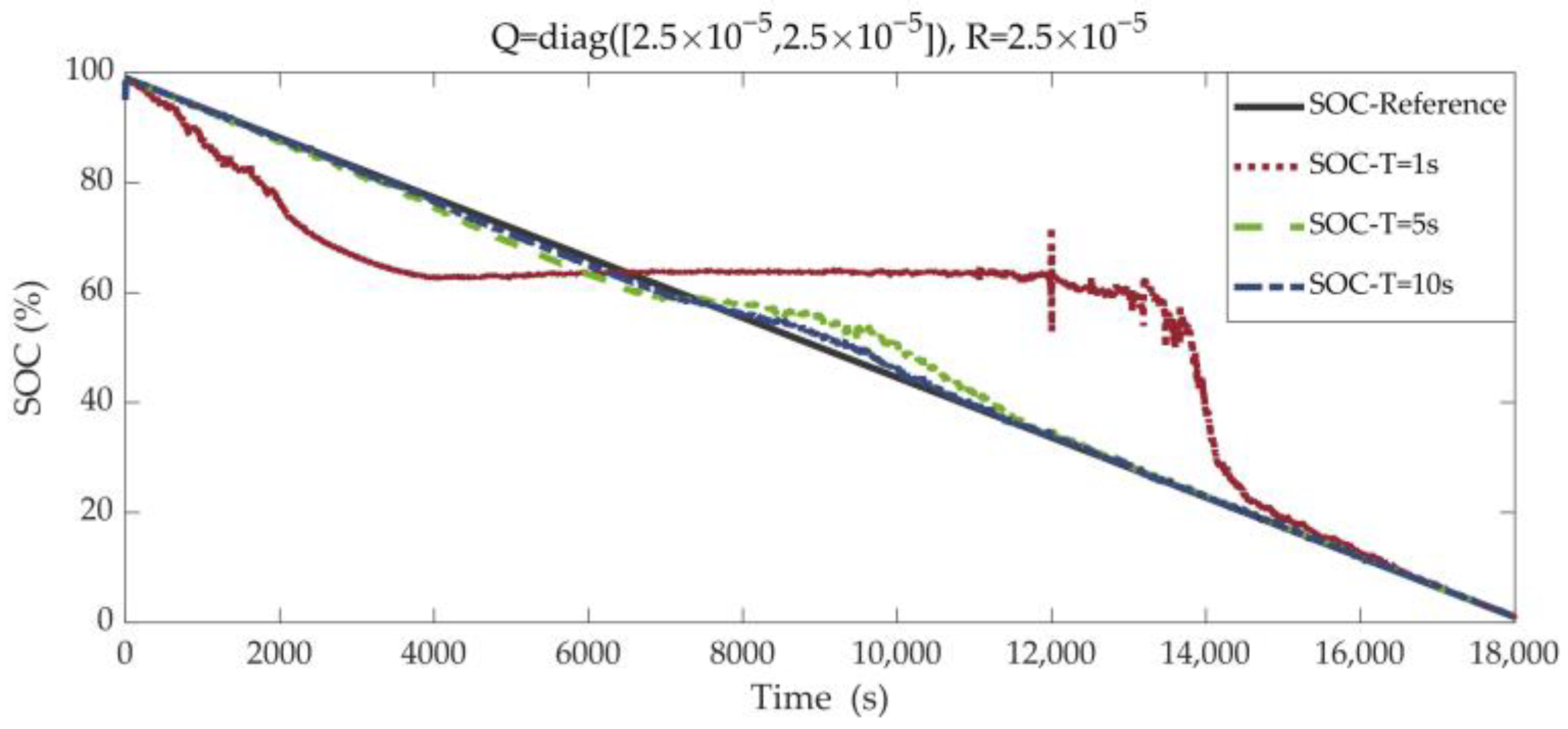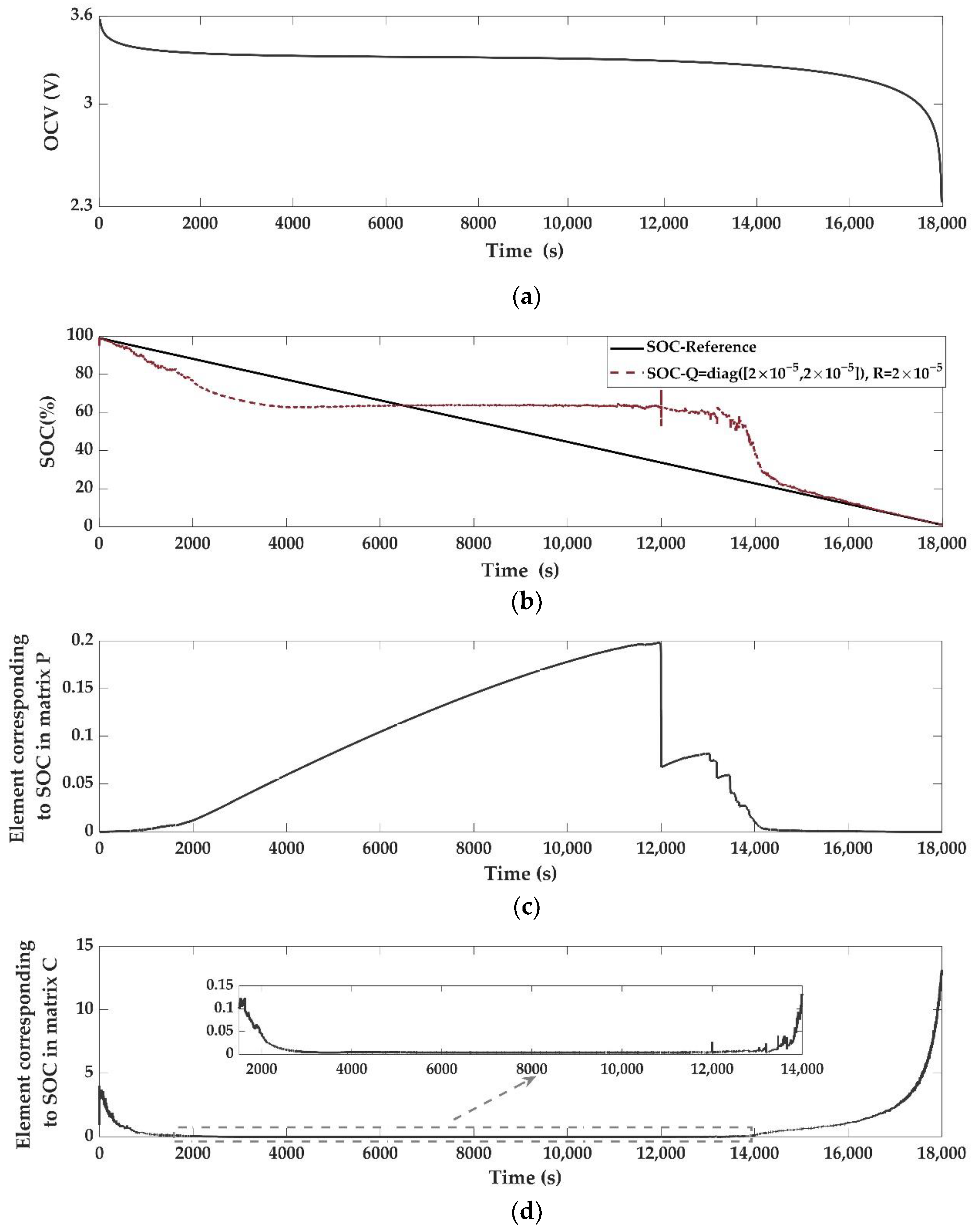Stability Analysis of EKF-Based SOC Observer for Lithium-Ion Battery
Abstract
:1. Introduction
2. EKF Stability Analysis Foundations
2.1. Algorithm Used in This Study
- (a)
- For every , is nonsingular, and there are real numbers such that and are fulfilled (throughout this paper, denotes the Euclidian norm of real vectors or the spectral norm of real matrices).
- (b)
- There are real numbers such that the following bounds on various matrices are fulfilled: , , , , .
- (c)
- The error covariance matrix is bounded via if there are .
- (d)
- There are positive real numbers such that the nonlinear function in Equation (2) and in Equation (3) are bounded via , , with and .
- (a)
- The first term on the right-hand side of Equation (6) is bounded via and there is . It represents the effect of various coefficient matrices in the recursive process.
- (b)
- The second term on the right-hand side of Equation (6) is bounded via , with , , . This term represents the effect of model nonlinearity on the error upper bound.
- (c)
- Since and are uncorrelated, the expectation value of the cross-terms containing both and will vanish. Then, there is .
- (d)
- The last term is bounded via , with .
2.2. Battery Model
3. EKF-Based SOC Observer Stability Analysis
3.1. System Parameters Analysis
3.2. System Nonlinearity Analysis
4. Numerical Analysis and Algorithm Improvement
4.1. Numerical Simulation and Analysis
4.1.1. Noise Analysis
4.1.2. Nonlinearity Analysis
4.2. Algorithm Performance Improvement
4.2.1. Theoretical Basis
4.2.2. Q and R Matrices Design
5. Conclusions
Author Contributions
Funding
Data Availability Statement
Conflicts of Interest
References
- Szumanowski, A.; Chang, Y. Battery management system based on battery nonlinear dynamics modeling. IEEE Trans. Veh. Technol. 2008, 57, 1425–1432. [Google Scholar] [CrossRef]
- Shi, D.; Zhao, J.; Wang, Z.; Zhao, H.; Eze, C.; Wang, J.; Lian, Y.; Burke, A.F. Cloud-Based Deep Learning for Co-Estimation of Battery State of Charge and State of Health. Energies 2023, 16, 3855. [Google Scholar] [CrossRef]
- Plett, G.L. Extended Kalman filtering for battery management systems of LiPB-based HEV battery packs: Part 2. Modeling and identification. J. Power Sources 2004, 134, 262–276. [Google Scholar] [CrossRef]
- Liu, X.T.; Li, K.; Wu, J.; He, Y.; Liu, X.T. An extended Kalman filter based data-driven method for state of charge estimation of Li-ion batteries. J. Energy Storage 2021, 40, 102655. [Google Scholar] [CrossRef]
- Hossain, M.; Haque, M.E.; Arif, M.T. Online Model Parameter and State of Charge Estimation of Li-Ion Battery Using Unscented Kalman Filter Considering Effects of Temperatures and C-Rates. IEEE Trans. Energy Convers. 2022, 37, 2498–2511. [Google Scholar] [CrossRef]
- Song, Y.; Grizzle, J.W. The Extended Kalman Filter as a local asymptotic observer for nonlinear discrete-time systems. In Proceedings of the American Control Conference, Chicago, IL, USA, 24–26 June 1992. [Google Scholar] [CrossRef]
- Baras, J.S.; Bensoussan, A.; James, M.R. Dynamic Observers as Asymptotic Limits of Recursive Filters: Special Cases. SIAM J. Appl. Math. 1988, 48, 1147–1158. [Google Scholar] [CrossRef] [Green Version]
- Lohmiller, W.; Slotine, J.J.E. On Contraction Analysis for Non-linear Systems. Automatica 1998, 34, 683–696. [Google Scholar] [CrossRef] [Green Version]
- Lohmiller, W.; Slotine, J.J.E. Contraction analysis of non-linear distributed systems. Int. J. Control 2005, 78, 678–688. [Google Scholar] [CrossRef] [Green Version]
- Boutayeb, M.; Rafaralahy, H.; Darouach, M. Convergence analysis of the Extended Kalman Filter used as an observer for nonlinear deterministic discrete-time systems. IEEE Trans. Autom. Control 1997, 42, 581–586. [Google Scholar] [CrossRef]
- Reif, K.; Sonnemann, F.; Unbehauen, R. An EKF-Based nonlinear observer with a prescribed degree of stability. Automatics 1998, 34, 1119–1123. [Google Scholar] [CrossRef]
- Reif, K.; Günther, S.; Yaz, E.; Unbehauen, R. Stochastic stability of the discrete-time Extended Kalman Filter. IEEE Trans. Autom. Control 1999, 44, 714–728. [Google Scholar] [CrossRef]
- Reif, K.; Günther, S.; Yaz, E.; Unbehauen, R. Stochastic stability of the continuous-time Extended Kalman Filter. IEEE Proc.-Control Theory Appl. 2000, 147, 45–52. [Google Scholar] [CrossRef]
- Waag, W.; Fleischer, C.; Sauer, D.U. On-line estimation of lithium-ion battery impedance parameters using a novel varied-parameters approach. J. Power Sources 2013, 237, 260–269. [Google Scholar] [CrossRef]
- Baras, J.S.; Krishnaprasad, P.S. Dynamic observers as asymptotic limits of recursive filters. In Proceedings of the 21st IEEE Conference on Decision and Control, Orlando, FL, USA, 8–10 December 1982. [Google Scholar] [CrossRef]
- Ljung, L. Asymptotic behavior of the extended Kalman filter as a parameter estimator for linear systems. IEEE Trans. Autom. Control 1979, 24, 36–50. [Google Scholar] [CrossRef] [Green Version]
- Grizzle, J.W.; Moraal, P.E. Newton, observers and nonlinear discrete-time control. In Proceedings of the 29th IEEE Conference on Decision and Control, Honolulu, HI, USA, 5–7 December 1990. [Google Scholar] [CrossRef]
- Boutayeb, M.; Aubry, D. A strong tracking extended Kalman observer for nonlinear discrete-time systems. IEEE Trans. Autom. Control 1999, 44, 1550–1556. [Google Scholar] [CrossRef]
- Gauthier, J.; Bornard, G. Observability for any u(t) of a class of nonlinear systems. IEEE Trans. Autom. Control 1981, 26, 922–926. [Google Scholar] [CrossRef]
- Dey, S.; Ayalew, B.; Pisu, P. Nonlinear Robust Observers for State-of-Charge Estimation of Lithium-Ion Cells Based on a Reduced Electrochemical Model. IEEE Trans. Control Syst. Technol. 2015, 23, 1935–1942. [Google Scholar] [CrossRef]
- Lotfi, F.; Ziapour, S.; Faraji, F.; Taghirad, H.D. A switched SDRE filter for state of charge estimation of lithium-ion batteries. Electr. Power Energy Syst. 2019, 117, 105666. [Google Scholar] [CrossRef]
- Casti, J.L. Recent Developments and Future Perspectives in Nonlinear System Theory. SIAM Rev. 1982, 24, 301–331. [Google Scholar] [CrossRef] [Green Version]
- Lee, E.B.; Markus, L. Foundations of Optimal Control Theory; John Wiley and Sons, Inc.: New York, NY, USA, 1967. [Google Scholar]
- Wang, X. Research on Observability of Nonlinear Systems Based on Linearization. Master’s Thesis, Harbin Institute of Technology, Harbin, China, 2009. [Google Scholar]
- Yang, X.D.; He, P.; Hu, H.Z. The Performance Analysis of Kalman Filter. Tech. Autom. Appl. 1999, 18, 17–19. [Google Scholar] [CrossRef]
- Deng, Z.L.; Yuan, G.; Mao, L.; Yun, L.; Hao, G. New approach to information fusion steady-state Kalman filtering. Automatica 2005, 41, 1695–1707. [Google Scholar] [CrossRef]
- Chen, G.; Hsu, S.H. Linear Stochastic Control Systems; CRC Press: New York, NY, USA, 1995. [Google Scholar]
- Rhudy, M.B.; Gu, Y. Online Stochastic Convergence Analysis of the Kalman Filter. Int. J. Stoch. Anal. 2013, 2013, 37–40. [Google Scholar] [CrossRef] [Green Version]










| |
| The estimated value: | The true value: |
| The ratio coefficient: | |
| |
| The estimated value: | The true value: |
| The ratio coefficient: | |
Disclaimer/Publisher’s Note: The statements, opinions and data contained in all publications are solely those of the individual author(s) and contributor(s) and not of MDPI and/or the editor(s). MDPI and/or the editor(s) disclaim responsibility for any injury to people or property resulting from any ideas, methods, instructions or products referred to in the content. |
© 2023 by the authors. Licensee MDPI, Basel, Switzerland. This article is an open access article distributed under the terms and conditions of the Creative Commons Attribution (CC BY) license (https://creativecommons.org/licenses/by/4.0/).
Share and Cite
Wang, W.; Fu, R. Stability Analysis of EKF-Based SOC Observer for Lithium-Ion Battery. Energies 2023, 16, 5946. https://doi.org/10.3390/en16165946
Wang W, Fu R. Stability Analysis of EKF-Based SOC Observer for Lithium-Ion Battery. Energies. 2023; 16(16):5946. https://doi.org/10.3390/en16165946
Chicago/Turabian StyleWang, Weihua, and Rong Fu. 2023. "Stability Analysis of EKF-Based SOC Observer for Lithium-Ion Battery" Energies 16, no. 16: 5946. https://doi.org/10.3390/en16165946
APA StyleWang, W., & Fu, R. (2023). Stability Analysis of EKF-Based SOC Observer for Lithium-Ion Battery. Energies, 16(16), 5946. https://doi.org/10.3390/en16165946






